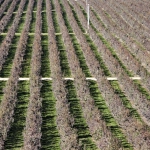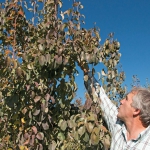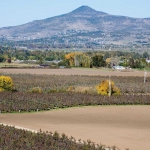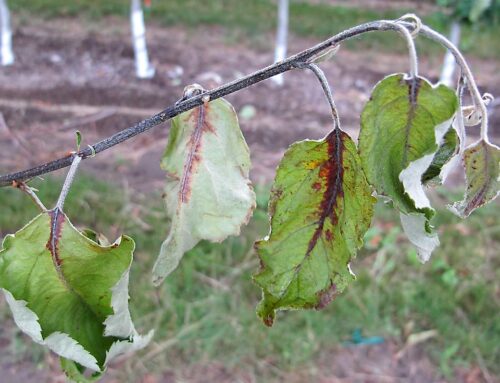A narrow focus on one variety and one market makes Bear Creek Orchards, Inc., unique.
Although the Medford, Oregon, company faces similar pest, production, and economic challenges as other tree fruit growers, being focused on one variety poses its own set of issues.
“We’re in our own little world because our mail order market is a little bit apart from most,” said Matt Borman, director of orchard operations for Bear Creek Orchards, Inc., a subsidiary (and the growing arm) of Harry & David LLC. “With the selection of Comice pears sold under the trademarked name Royal Riviera as our bread-and-butter variety, we have to accept certain management challenges that come with that cultivar.”
Comice scuff and mark easily, and the variety is low yielding, he explained.
“We have all of the common challenges that agriculture faces—labor, water, production issues—as well as those that come with growing Comice,” Borman said.
Few growers produce Comice or have the infrastructure to handle the delicate fruit on a large scale, so outside sources of Comice are limited. To control quality, the company brought production in house to be able to control everything from start to finish.
The cultivar russets easily and can have poor fruit finish if timing of protective materials is not perfect.
“Comice has a smaller crop protection toolbox than other varieties due to sensitivity towards russeting. Sulfur and copper can be used but in very small windows during the dormant season,” he said. “There are days I wish we could discover a wonderful variety that was easier to grow.”
If all goes right, the crop is nestled in a gift basket and sold by the end of December. However, some fruit is commercially packed and sold on the wholesale market.
Packout rates for Comice gift fruit range from 35 to 65 percent, depending on the year and orchard, said Borman. He added that the variety typically only stores with good quality through January and into early February.
“The commercial market for Comice is challenging, so much of the nongift grade goes to a local processor,” he said. “For us, if the fruit isn’t high enough quality for the gift grade, decisions have to be made as to whether the value will cover the cost of harvest and processing.”
Last season, pockets of lower quality fruit hit by hail were left on the tree.
High density how-to
Borman, who’s been with the company for nearly 15 years, is responsible for keeping 1,629 acres of pear orchards productive, healthy, and profitable.
In the mid-1990s, Bear Creek Orchards planted its first high-density block of Comice as a means of maintaining productivity. They now have 75 acres of high-density plantings with 830 trees per acre, planted five feet between trees, ten feet between rows. Provence Quince rootstock works well in their high-density Comice plantings.
The majority of acreage is spaced at 7 by 14 feet, with some variations that range from to 6 by 13 feet to 10 by 18 feet in older blocks.
“Our overall average production for our 1,566 acres of Comice is around 10 tons per acre,” he said. “But in the high density, we average 14 to 15 tons per acre. There are blocks on wider spacings that can reach 15 tons to the acre, but they are on some of the most vigorous, alluvial soils in the valley.
“With some of our original attempts at high density nearly 50 years old now, there doesn’t seem to be any reason not to continue to plant trees closer together.”
When trees are so close together, limiting tree height is critical to maximizing fruiting wood and light interception. The tight row space means shorter trees—between 9 and 12 feet tall, depending on row width.
“Harvest crews can pick 60 to 70 percent of the fruit without climbing a ladder,” he said, adding that orchards of the future need to be suited for platforms and automation. “Our goal over time is to get as much production as we can from ground level and be able to sustain yields, year after year. We want to do that for worker safety issues as well as picker efficiencies.”
Viable industry
Harry & David’s Royal Riviera pears are grown for the Christmas gift season. A high percentage of the Comice pears used for gifts come from Bear Creek Orchards. But in recent years, they have introduced fruit from a few outside growers into their pack as a way to keep Medford’s pear industry viable.
The Rogue Valley’s agricultural community is at a critical point between the pear and wine grape industries, he said.
Borman believes agricultural services like equipment and parts, chemicals, and irrigation supplies could be negatively impacted if critical size is not maintained. The loss of any large growers in the community would be felt by all, he said.
“If we can help keep the pear industry viable, it helps everybody. We don’t benefit by isolating ourselves. We try to be very open and sharing with what we’re doing horticulturally.”
Bear Creek Orchards as well as other growers in the valley have played a major role in helping fund the cash-strapped county extension service and have partnered closely with researchers from Oregon State University.
Bear Creek and others have provided research funding and in-kind support and continue to work closely with university scientists from California and Washington.
Borman is planting three new blocks of Comice pears, totaling 100 acres, this spring, along with another 11 acres of peaches.
The company is also discussing planting wine grapes in the near future, a crop that is making inroads in the Rogue River Valley. Bear Creek Orchards has fallow ground to continue replanting Comice, but has identified areas that might be better suited for vineyards.
There’s a possibility that Harry & David would grow their own wine grapes in the future.
“It fits with the Harry & David model of controlling quality throughout the process, from growing fruit to delivering it to the customer,” he said. “With everything we’ve learned about Comice and delivering the best quality that we can to the customer, it makes sense to grow the varieties of crops that do best in our climate.” •
———————
Surviving ups and downs
For nearly 80 years, Harry & David, a fruit company based in Medford, Oregon, has used the mail system, instead of grocery store markets, to deliver specialty fruit and gourmet foods to customers.
During the Great Depression of the 1930s, Medford orchardists Harry and David Holmes were having difficulty selling their Bear Creek Orchard fruit in traditional markets. Trying a new approach, the brothers sent letters and boxes of their specialty pears to business tycoons in San Francisco and New York and convinced them to purchase fruit, delivered by mail, for gifts.
The brothers learned that people, even in the early 1930s, would pay the price for premium, high quality fruit. In 1936, they developed a fruit-of-the-month club to extend the gift season.
Today, Harry & David is a business worth $370 million, according to its June 2012 financial report.
Through the company catalog, Internet sales, and retail stores scattered across the country, Harry & David now sells specialty Comice pears trademarked as Royal Riviera, homegrown trademarked Oregold peaches, outside sourced fruit, gourmet desserts, snacks, various foods, flowers, and most recently, branded wine, both domestic and imported.
———————
Challenges in growing one variety
Managing labor and pest concerns for more than 1,700 acres of tree fruit is no easy feat, especially if most acreage is one variety requiring horticultural tasks to be done at the same time.
Matt Borman manages both organic and conventional orchards for Bear Creek Orchards, Inc., the growing arm of the famed Harry & David mail order company. The company has 1,566 acres of Comice pears, 63 acres of Bosc, and 55 acres of peaches.
Bear Creek Orchards has been certified organic since 2006 (when it converted 50 acres from conventional to organic tree fruit production) and continues to farm 50 acres of organic tree fruit.
With nearly 1,600 acres of one variety to pick in a short window, having enough labor is critical.
Borman said close communication with work groups outside the Rogue Valley helps generate pickers, but it’s also important to offer housing and good food. Bear Creek provides housing for about 275 workers each summer.
The 55 acres of peaches grown by Bear Creek fit well with the company’s Comice pear production, Borman said, explaining that peach harvest finishes a couple days before Comice harvest begins, allowing him to keep a core group of about 40 peach workers who transition to pears.
A year-round crew of about 100 workers is employed by Bear Creek for pruning and other jobs, but the company ramps up to about 320 pickers for pear harvest. The goal is to hand pick about 750 tons of fruit per day.
“We know that down the road, something like the H-2A program [a federal program for foreign guest-workers] may be the solution, so we’ve patterned our pay schedules, services, and resources after H-2A so that it won’t be so painful if we have to switch,” he said. “We could house up to 360 workers if we had to.”
One of the biggest challenges of growing fruit in Medford is the proximity to urban areas, Borman said.
Pest management
“I have one farm that borders a single house on three sides and another orchard that has a church on one side and a school on the other. Between school, soccer practices, soccer matches on Saturdays and church on Sundays, we have to carefully consider pest control application methods and timing to ensure a safe environment for our workers and community neighbors.”
Borman uses experiences and knowledge gained from the organic blocks to soften his approach in the conventional orchards. Mating disruption is used in all of Bear Creek Orchard’s pear and peach orchards. Moreover, in 60 percent of the company’s 1,700 acres, pest monitoring and trapping is done in four-acre increments.
A field scouting team visits each orchard acre every week, bringing leaves into the lab to count the various pest stages to determine populations.
Economic thresholds guide spraying decisions.
Thresholds are the pest population numbers beyond which economic damage will occur if they are not controlled.
The intense monitoring helps identify pest hot spots and allows the orchard team to target areas as small as four acres.
“By pinpointing emerging pest populations, we’ve been able to greatly reduce our use of cover sprays,” he said. “The end game, when we’re that focused and present, is that we have higher quality fruit and see the benefits of the materials we use.”











Leave A Comment